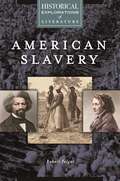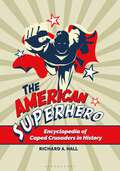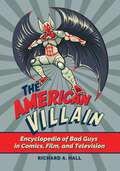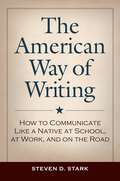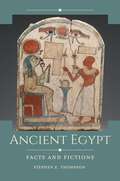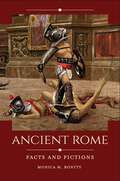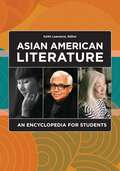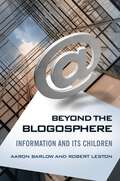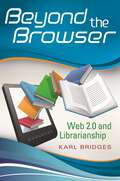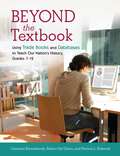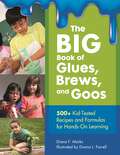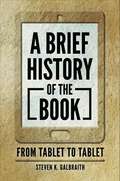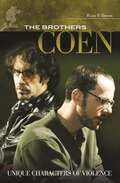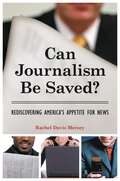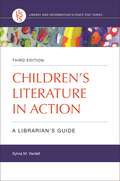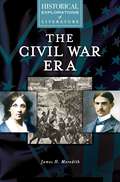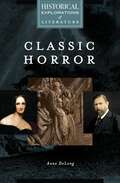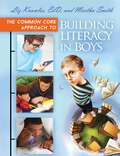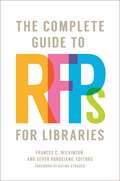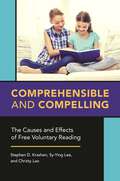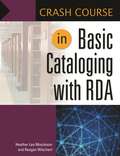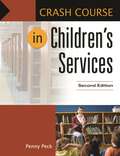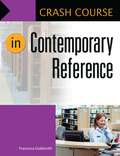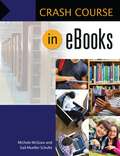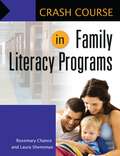- Table View
- List View
American Slavery: A Historical Exploration of Literature (Historical Explorations of Literature)
by Robert FelgarUtilizing key selections from American literature, this volume aligns with ELA Common Core Standards to give students a fresh perspective on and a keener understanding of slavery in the United States.Slavery is a central feature of American history, one with which the nation still has not come fully to terms. In this book, that seminal topic is examined in a fresh way—through literature. Organized chronologically to show evolving attitudes toward American slavery in the 19th century, the work focuses on four key 19th-century texts that are frequently taught, using them as a gateway for understanding this critical period and why slavery had to be destroyed if the Union was to be maintained.In addition to examining the four works—Frederick Douglass's Narrative of the Life of Frederick Douglass, Harriet Beecher Stowe's Uncle Tom's Cabin, Harriet Jacobs's Incidents in the Life of a Slave Girl, and Mark Twain's Huckleberry Finn—the book also provides numerous historical documents that contextualize slavery in the literary texts. These documents make it dramatically clear why issues such as abolition and the Fugitive Slave Law of 1850 were so controversial for 19th-century Americans. Aligned with the ELA Common Core Standards, the title supports history teachers with insights into classic literary works, and it enhances the English curriculum with rich elaborations of relevant historical context.
The American Superhero: Encyclopedia of Caped Crusaders in History
by Richard A. HallThis compilation of essential information on 100 superheroes from comic book issues, various print and online references, and scholarly analyses provides readers all of the relevant material on superheroes in one place.The American Superhero: Encyclopedia of Caped Crusaders in History covers the history of superheroes and superheroines in America from approximately 1938–2010 in an intentionally inclusive manner. The book features a chronology of important dates in superhero history, five thematic essays covering the overall history of superheroes, and 100 A–Z entries on various superheroes. Complementing the entries are sidebars of important figures or events and a glossary of terms in superhero research. Designed for anyone beginning to research superheroes and superheroines, The American Superhero contains a wide variety of facts, figures, and features about caped crusaders and shows their importance in American history. Further, it collects and verifies information that otherwise would require hours of looking through multiple books and websites to find.
The American Villain: Encyclopedia of Bad Guys in Comics, Film, and Television
by Richard A. HallThe American Villain: Encyclopedia of Bad Guys in Comics, Film, and Television seeks to provide one go-to reference for the study of the most popular and iconic villains in American popular culture.Since the 1980s, pop culture has focused on what makes a villain a villain. The Joker, Darth Vader, and Hannibal Lecter have all been placed under the microscope to get to the origins of their villainy. Additionally, such bad guys as Angelus from Buffy the Vampire Slayer and Barnabas Collins from Dark Shadows have emphasized the desire for redemption—in even the darkest of villains. Various incarnations of Lucifer/Satan have even gone so far as to explore the very foundations of what we consider "evil." The American Villain: Encyclopedia of Bad Guys in Comics, Film, and Television seeks to collect all of those stories into one comprehensive volume. The volume opens with essays about villains in popular culture, followed by 100 A–Z entries on the most notorious bad guys in film, comics, and more. Sidebars highlight ancillary points of interest, such as authors, creators, and tropes that illuminate the motives of various villains. A glossary of key terms and a bibliography provide students with resources to continue their study of what makes the "baddest" among us so bad.
The American Way of Writing: How to Communicate Like a Native at School, at Work, and on the Road
by Steven D. StarkExplains the uniquely American cultural references that appear in American English for students and professionals to increase their written command of the language.Language is a window into the soul of a culture. The hardest part for newcomers who want to master American English is not learning the alphabet, grammar, or vocabulary — it's understanding the distinctive way Americans approach the world. This book shows readers how to do just that. The American Way of Writing guides readers through the nuances of American English, providing a toolkit for non-native speakers who come to the United States to study, as well as international business and legal professionals who have to work and communicate with Americans in a professional or business context. Understanding what makes Americans uniquely "American" is a challenging subject for anyone to master. Such characteristics are always in flux and a source of constant debate. Steven D. Stark's comprehensive approach to American English in The American Way of Writing is suited to Americans and foreigners alike, offering a deeper understanding of the ties that bind rather than divide.
Ancient Egypt: Facts and Fictions (Historical Facts and Fictions)
by Stephen E. ThompsonComprising a unique collection of primary sources, this book critically examines several topics relating to ancient Egypt that are of high interest to readers but about which misconceptions abound.With its pyramids, mummies, and sphinxes, ancient Egypt has fascinated us for centuries. It has been the setting of many films and novels, figuring prominently in popular culture. Much of what the average reader believes about this civilization, however, is mistaken. Through a unique collection of primary source documents, this book critically examines several topics related to ancient Egypt and about which misconceptions abound.Primary sources, many in new translations by the author, are drawn from ancient Egyptian, classical Greek and Roman, Muslim, early Christian, and modern European documents. These sources shed light on popular misconceptions. Such topics include the divinity of the pharaoh, the role of animals in ancient Egyptian religion, the purpose of the Egyptian pyramids, the use of slave labor, the Egyptian hieroglyphic writing system, the role of Cleopatra in the defeat of Marc Antony and the fall of the Roman Republic, and the influence of Egyptian religion on the development of early Christianity. By studying these documents, users will be able to develop their skills interpreting and evaluating primary sources.
Ancient Rome: Facts and Fictions (Historical Facts and Fictions)
by Monica M. BonttyThis book shares little-known facts from and excerpts of primary source documents to correct popular misconceptions about Ancient Rome and to show how those misconceptions became widespread.Roman personalities and history have always had a larger-than-life profile in American popular culture, but most people think of this ancient civilization as merely decadent, cruel, and elitist. Most of our stereotypical conceptions of the empire and its people, however, are wrong. This book corrects popular misconceptions about the ancient Roman world, thus making ancient history relevant and accessible to modern readers and allowing modern critics of American politics and society to draw accurate comparisons.Each chapter discusses how a particular misconception developed, spread, and evolved into what we now believe to be the historical truth. Topics discussed include crucifixion, the destruction of Carthage, Julius Caesar's last words, and Roman hygiene. Excerpts from primary source documents provide evidence of both the rise of the historical fictions and the truths behind the myths.
Asian American Literature: An Encyclopedia for Students
by Keith LawrenceAsian American Literature: An Encyclopedia for Students is an invaluable resource for students curious to know more about Asian North American writers, texts, and the issues and drives that motivate their writing.This volume collects, in one place, a breadth of information about Asian American literary and cultural history as well as the authors and texts that best define it.A dozen contextual essays introduce fundamental elements or subcategories of Asian American literature, expanding on social and literary concerns or tensions that are familiar and relevant. Essays include the origins and development of the term "Asian American"; overviews of Asian American and Asian Canadian social and literary histories; essays on Asian American identity, gender issues, and sexuality; and discussions of Asian American rhetoric and children's literature. More than 120 alphabetical entries round out the volume and cover important Asian North American authors. Historical information is presented in clear and engaging ways, and author entries emphasize biographical or textual details that are significant to contemporary young adults. Special attention has been given to pioneering authors from the late 19th century through the early 1970s and to influential or well-known contemporary authors, especially those likely to be studied in high school or university classrooms.
Beyond the Blogosphere: Information and Its Children
by Aaron Barlow Robert Leston Ph.D.This book looks at questions and answers pertaining to the organization, usage, and ownership of information in the Internet age—and the impact of shifting attitudes towards information ownership on creative endeavors.In the competing traditions of Marshall McLuhan and Langdon Winner, authors Aaron Barlow and Robert Leston take readers on a revealing tour of the Internet after the explosion of the blogosphere and social media. In the world Beyond the Blogosphere, information has surpassed its limits, the distinction between public and private selves has collapsed, information is more untrustworthy than it ever was before, and technology has exhibited a growth and a desire that may soon exceed human control. As Langdon Winner pointed out long ago, "tools have politics." In an eye-opening journey that navigates the nuances of the cultural impact the internet is having on daily life, Barlow and Leston examine the culture of participation in order to urge others to reconsider the view that the Internet is merely a platform or a set of tools that humans use to suit their own desires. Provocative and engaging, Beyond the Blogosphere stands as a challenge on how to rethink the Internet so that it doesn't out-think us.
Beyond the Browser: Web 2.0 and Librarianship
by Karl BridgesAuthored by an experienced librarian, digital resource manager, and professor in the field of library science, this book explores the wide-reaching impact of second-generation web technologies on library organization and services—and how library staff must respond.Most librarians are infinitely familiar with the Internet due to their daily use of this essential resource. However, having practical expertise with today's digital resources does not guarantee the ability to speak intelligently and convincingly about their less-obvious benefits to funding authorities—an important skill to have. Beyond the Browser: Web 2.0 and Librarianship overviews the history of libraries and the Internet to provide necessary perspective and then examines current and future trends in libraries. In Part I, the author traces the notion of connectivity from its roots in the 19th century through the rise of digital technology in the second half of the 20th, concluding with a discussion of its influence on the role expectations and performance of today's information professional. Part II investigates the evolutionary impact of open access, scholarly inquiry, and second-generation web technologies on library organization and services. A bibliography of helpful resources is also included.
Beyond the Textbook: Using Trade Books and Databases to Teach Our Nation's History, Grades 7–12
by Carianne Bernadowski Patricia L. Kolencik Robert Del GrecoThis collection of standards-based lessons will guide middle and high school teachers while teaching the nation's history in a user-friendly, ready-made fashion.During a time of standards-based instruction, Beyond the Textbook: Using Trade Books and Databases to Teach Our Nation's History, Grades 7–12 will fill the gap in today's middle and high school classrooms to simultaneously engage students in effective literacy skill exercises and teach our nation's history. Authored by three experienced former public school teachers, these ready-made lesson plans for classroom teachers and school librarians make planning easy for implementation in a social studies, history, or English classroom. The book covers topics from Native Americans to the Louisiana Purchase, offering evidence-based reading strategies throughout that can hold adolescents' attention and develop their vocabulary and comprehension. Each chapter will include bibliographic information; suggested grade level; Information Literacy and National Social Studies Standards; before, during, and after reading strategies; database integration for classroom use; and suggested readalikes. Users will find the standards and evidenced-based research perfectly applicable in today's classrooms.
The BIG Book of Glues, Brews, and Goos: 500+ Kid-Tested Recipes and Formulas for Hands-On Learning
by Diana F. MarksThis compilation is a must-have for every library, providing a multitude of methods for developing easy, interesting activities for children. Projects across cultures, recipes for healthy snacks, and intriguing science experiments are among the hundreds of ideas connecting learning and creativity for students of all ages.Here's a book to help students create cross-disciplinary projects by using materials they make themselves. From clays and dough, to compounds and crystals, to healthy treats and snacks, children can access the formulas and recipes to make them all! This updated resource combines everything from the former two volumes into one comprehensive edition and features even more recipes, additional relevant content, and expanded connections between activities and curriculum. Every activity provides you with easy-to-follow, step-by-step directions. Each tried-and-true, safe concoction uses easily obtainable ingredients and provides suggestions for determining why and when each formula can be used. The book contains recommendations for linking projects to curriculum to help make each activity relevant and educational. Organized into 33 chapters, projects include making musical instruments, growing and using plants, conducting science experiments, and preparing food for ourselves and other creatures.
A Brief History of the Book: From Tablet to Tablet
by Steven K. GalbraithThis book leads readers through an intriguing examination of how books began and have evolved through history and explores where future technologies may lead them.From ancient clay tablet and scrolls to medieval manuscripts and printed books to personal computers and iPads, this guide examines the fascinating history of books from 4000 BCE to the present. At each step of this evolution, technologies are examined and evaluated to show how these ideas are present from the very beginning of written communication. Moving chronologically from the ancient world to the present, the book shows how written communication media evolved from cuneiform to the Kindle. Focusing on key technologies and vital periods of historical transition, it traces an evolution that elucidates the history of the written word, at each step examining and evaluating such aspects of technologies as memory capacity, readability and writability, durability, recyclability, information security, ease and mode of access, and cost. Additional attention is paid to how these technologies were made, how they were circulated, and who was reading them.
The Brothers Coen: Unique Characters of Violence (Modern Filmmakers)
by Ryan P. DoomThis examination of the distinctive cinema of Joel and Ethan Coen explores the theme of violence in their wide-ranging body of work.The Brothers Coen: Unique Characters of Violence spans the career of the two-time Oscar-winning producer/director team, exploring the theme of violence that runs through a genre-spanning body of work, from the neo-noir of Blood Simple to the brutal comedy Burn After Reading (2008).In chapters focusing on major characters, Ryan Doom looks at the chaotic cinematic universe of the Coens, where violent acts inevitably have devastating, unintended consequences. The remarkable gallery of Coen characters are all here: hardboiled gangster Tom Regan from Miller's Crossing (1990), overmatched amateur kidnapper Jerry Lundergaard from Fargo (1996), accidental private eye "The Dude" from The Big Lebowski (1998), psychopathic assassin-for-hire Anton Chigurh from the 2007 Academy Award winner No Country for Old Men, and more.
Can Journalism Be Saved?: Rediscovering America's Appetite for News
by Rachel Davis MerseyThis book challenges the once-dominant social responsibility model and argues that a new, "individual-first" paradigm is what will allow journalism to survive in today's crowded media marketplace.By some measures, it would seem that print journalism is dying. Journalism recently suffered one of its worst circulation declines in years: a drop of more than ten percent in the a six month period ending September 30, 2009. The Rocky Mountain News in Denver, CO, closed its doors in 2009—after it dominated the AP awards in 2008, and was lauded for an investigative expose on unfair treatment of former nuclear workers. Even the New York Times and the Washington Post are experiencing financial trouble. But print advertising revenue still trumps online advertising revenue ten-fold. Is there hope yet for traditional journalism?This book reviews the complicated challenge facing journalism, tracing its 19th-century community-oriented origins and documenting the vast expansion of the news business via blogs and other Internet-enabled outlets, user-generated content, and news-like alternatives. The author argues that a radical shift in mindset—striving to meet each individual's demands for what he wants to know—will be necessary to save journalism.
Children's Literature in Action: A Librarian's Guide (Library and Information Science Text Series)
by Sylvia M. VardellThis practitioner-oriented introduction to literature for children ages 5–12 covers the latest trends, titles, and tools for choosing the best books and materials as well as for planning fun and effective programs and activities.The third edition of Children's Literature in Action provides an activity-oriented survey of children's literature for undergraduate and graduate students seeking licensure and degrees that will lead to careers working with children in schools and public libraries. Author Sylvia M. Vardell draws on her 30 years of university teaching and extensive familiarity with the major textbooks in the area of children's literature to deliver something different: a book that focuses specifically on the perspective and needs of the librarian, with emphasis on practical action and library applications. Its contents address seven major genres: picture books, traditional tales, poetry, contemporary realistic fiction, historical fiction, fantasy, and informational books. Each chapter includes practical applications for the educator who shares books with children and who develops literature-based instruction. Chapters are enriched by author comments, collaborative activities, featured books, special topics, and activities including selected awards and celebrations, historical connections, recommended resources, issues for discussion, and assignment suggestions. This new edition incorporates the 2018 AASL National School Library Standards.
The Civil War Era: A Historical Exploration of Literature (Historical Explorations of Literature)
by James H. MeredithThis intriguing study examines the truth behind the myths and misconceptions that defined the American Civil War, as portrayed through the popular literary works of the time.The Civil War Era: A Historical Exploration of Literature examines the tremendous change the American Civil War brought to society as reflected in the literature of the time. It delves into the cultural, historical, and literary contexts of the era, looking beyond common conceptions and instead reflecting on the era's complexities and contradictions.The book profiles key American literature related to the war, both on and off the battlefield, including Stephen Crane's The Red Badge of Courage, Ambrose Bierce's "Chickamauga," Louisa May Alcott's Hospital Sketches, the Civil War poems of Walt Whitman and Herman Melville, and Lincoln's "Gettysburg Address." This book serves to demonstrate how profoundly the actions on the Civil War battlefield shaped American politics, society, and the arts.
Classic Horror: A Historical Exploration of Literature (Historical Explorations of Literature)
by Anne DeLongA valuable resource for readers exploring the classic horror genre, this book presents primary source documents alongside analysis in an examination of the social, political, and economic factors reflected in 19th century Gothic literature.The nineteenth century was a time of social, cultural, and economic change; revolutionary scientific developments; and enduring imaginative works. This book explores the classic horror genre of Gothic literature in its historical and social contexts. It contains chapters on four major works of classic horror, with each chapter providing a mix of background information, primary source historical documents, and analysis that will appeal as much to high school and college students as to lovers of literature and the Victorian era.Coleridge's The Rime of the Ancient Mariner is contextualized through documents pertaining to British imperialism, Antarctic Exploration, and the burgeoning environmentalist movement. Shelley's Frankenstein is explored through sections on galvanism, electricity, grave robbing, and the vitalist debate. Stevenson's The Strange Case of Dr. Jekyll and Mr. Hyde is read through explanations of nineteenth-century drug use and addiction and early theories of psychology and criminology. Stoker's Dracula is studied with reference to such topics as mesmerism, clairvoyance, alienism, medical ethics, xenophobia, and Victorian pseudoscience.
The Common Core Approach to Building Literacy in Boys
by Liz Knowles Martha SmithWritten with a focus on the English Language Arts Common Core Standards, this book provides a complete plan for developing a literacy program that focuses on boys pre-K through grade 12.Despite the fact that reading and literacy among boys has been an area of concern for years, this issue remains unresolved today. Additionally, the emphasis and focus have changed due to the implementation of the English Language Arts Common Core Standards. How can educators best encourage male students to read, and what new technologies and techniques can serve this objective? The Common Core Approach to Building Literacy in Boys is an essential resource and reference for teachers, librarians, and parents seeking to encourage reading in boys from preschool to 12th grade.Providing a wide array of useful, up-to-date information that emphasizes the English Language Arts Common Core Standards, the bibliographies and descriptions of effective strategies in this book will enable you to boost reading interest and performance in boys. The chapters cover 16 different topics of interest to boys, all accompanied by a complete bibliography for each subject area, discussion questions, writing connections, and annotated new and classic nonfiction titles. Information on specific magazines, annotated professional titles, books made into film, websites, and apps that will help you get boys interested in reading is also included.
The Complete Guide to RFPs for Libraries
by Katina Strauch Frances C. Wilkinson Sever BordeianuThis comprehensive book covers the philosophy behind RFPs to prime readers to understand how to most effectively write them and provides instruction on navigating the submission process as it applies to multiple types of libraries.For many years, only large academic and public libraries and a few library systems regularly used RFPs. Now, smaller schools, public libraries, and library systems use RFPs as tools to select vendors for computer equipment, online systems, databases, and materials. Library consortia frequently use RFPs to select databases and integrated library systems. In this useful book, readers will learn more about the types and advantages of RFPs; the timelines and logistics for submitting RFPs; how to write different types of RFPs; how to evaluate vendor performance; the transfer process when a new vendor is selected; vendor perspectives; and RFP ethics. An appendix includes sample RFPs and evaluation materials, and a glossary defines language necessary to writing and understanding RFPs. This book is essential reading for librarians who need to select vendors to provide library materials including books, serials, and media in all formats as well as for those who are choosing integrated library systems, security and inventory systems such as RFID, computer equipment and software, online and streaming materials such as books and music, or services such as digitization.
Comprehensible and Compelling: The Causes and Effects of Free Voluntary Reading
by Stephen D. Krashen Sy-Ying Lee Christy LaoA joint effort from three thought leaders in educational research, linguistics, and literacy acquisition, this book explores the latest research that shows that compelling comprehensive input (CCI) is the baseline for all language and literacy development.It has been established that encouraging reading at all student levels supports literacy—not just literacy in terms of having basic reading and writing abilities, but in being able to perform advanced reading as well as having well-developed listening, speaking, and critical thinking skills. But what kind of reading has the most benefit for young learners? And why? Comprehensible and Compelling: The Causes and Effects of Free Voluntary Reading examines the most recent research and literacy testing results from around the world that document how reading materials must be comprehensible and compelling to bring success. It also presents research findings that show how libraries directly support literacy development, providing arguments and proof that will be invaluable in advocacy efforts for funding and program development.
Crash Course in Basic Cataloging with RDA (Crash Course)
by Heather Lea Moulaison Raegan Wiechert ProfessorCovering tools, terminology, and the FRBR-based RDA approach to description, this book explains the current principles of organization of information and basic cataloging practices for non-catalogers, enabling readers to understand elements of the cataloging process and interact with records in a basic manner.Organization of information and cataloging is often the most daunting task for library technicians and non-catalogers working in the library. New RDA cataloging rules can be baffling for even the more seasoned catalogers. Written by two authors with 20 years' combined experience in cataloging instruction, Crash Course in Basic Cataloging with RDA approaches current principles of organization of information and cataloging practices from a basic standpoint for non-catalogers. It makes a complex topic easy to understand and a complicated practice doable for those without the proper training and necessary experience.The book gives readers a basic understanding of organization of information and cataloging practice, explaining how records are created and the approaches to different formats of information in libraries, including MARC records and encoding RDA cataloging records; offering assistance in applying RDA; identifying the cataloger's tools; and providing non-technical explanations for the tasks that today's catalogers do. It contains an introduction, a bibliography/webliography, and three appendices of additional resources (Cataloging Tools, Resources for Catalogers, and Sample Catalog Records).
Crash Course in Children's Services (Crash Course)
by Penny PeckUseful for newcomers to the children's library staff as well as longtime children's librarians, the second edition of this popular handbook provides easy-to-follow instructions to make innovations in children's library materials work for you.Addressing everything from the basics of reference to the complex and highly specialized duties of program development, this handbook is perfect for both librarians and support staff who are assigned to the children's department of a library. This second addition of Crash Course in Children's Services covers many of the new issues facing children's library staff, including eBooks, using apps in programming, other online reading options, book trailers, nonfiction and the Common Core curriculum. It also describes expanded programming options such as makerspaces, gaming, dog reading programs, and play at storytime.Ideal for new children's librarians as well as experienced library staff who have not worked with children recently and long-time children's librarians looking to add new skills to their tool kits, the book familiarizes readers with all the new developments of the past few years, from online reading options to the wealth of new programming aimed at youth. You'll learn about subjects such as pop-up and passive programming, offering online homework help, and outreach and services to special needs children, and then quickly implement new practices into use at your library.
Crash Course in Contemporary Reference (Crash Course)
by Francisca GoldsmithA fresh, detailed, and thoughtful examination of reference services in the context of evolving community information needs and habits, a changing technological landscape, and new search strategies.Professional practices in the field of library reference services have changed dramatically in the past decade in response to shrinking print reference collections and evolving technology, search strategies, and user needs and interests. This new guide explains all the basics of reference services, covering resource types and awareness of their appropriate uses, collection development and maintenance techniques that support reference service work, the latest online searching techniques, and best practices for service interactions through various platforms, including email, chat, text, phone, and face to face. Additionally, it addresses reference service ethics; communication and conducting reference interviews; important policies related to reference service development, provision, and maintenance; alternative reference service delivery points now in use; and professional service provider networking.Both experienced reference librarians and those new to reference service will benefit from in-depth coverage of recent changes in online reference resources and print-based resources, guidelines for authoritative evaluation of web-based resources, explanations of online catalog searching skills, and tips for reference web page construction. The book also contains an expanded section on making digitized collections accessible and relevant; information on the growing need of members of the general population for help with various federal government access programs ranging from Veterans Affairs and Social Security to health care access, income tax regulation fulfillment, and immigrant documentation; and explanations of copyright in the digital sphere of resource use and transfer.
Crash Course in eBooks (Crash Course)
by Michele McGraw Gail Mueller SchultzEverything you need to know about eBooks is explained in this holistic guide to a new world of reading—from selection and curation of an eBook collection to training and support for staff and patrons.EBooks are a must for today's libraries, making this introduction indispensable for those who have yet to delve into the ever-expanding universe of downloadable material. This "crash course" is an easy-to-use, hands-on approach that will simplify the decision and implementation processes. It introduces you to eBooks and eReading and covers the many issues surrounding eBooks in circulating libraries including technology, acquisition, and training. You'll learn how to launch a program, what to buy, how to let your public know you've added eBooks to your collection, and how to circulate the materials. The guide will also help you with decisions like vendor selection, how many eBooks to purchase, which delivery platforms to employ, how best to offer access, and licensing agreements. Chapters can be consulted as stand-alone overviews of key areas, or the book can be used as a source of holistic instruction. While it will be especially useful to small or rural circulating libraries, including public libraries, school libraries, and specialty libraries that may have a small staff responsible for all aspects of library service, tips on things like promoting an eBook collection are pertinent to enhancing any collection.
Crash Course in Family Literacy Programs (Crash Course)
by Rosemary Chance Laura ShenemanThis book collects the research on literacy, information regarding the importance of reading to children, sources of funding, and places to find information about literacy programs in the 50 states—all in a single volume.Family literacy programs can be remarkably effective in helping families who struggle in various areas of literacy or supporting their children's academic needs.Crash Course in Family Literacy Programs provides an introduction and an overview of this critical subject, defining what literacy, family literacy, and family literacy events are, and covering critical topics such as sources of funding, conclusions of recent research, and bilingual family literacy. The first half of the book is focused on laying out background information about family literacy, while the remainder provides practical how-to information for public and school libraries to develop their own family literacy programming. The book shows perspectives of public librarians, school principals, children's book store owners, and school personnel who have successfully implemented a family literacy program. Planning sheets and lesson templates are included, making it easy to develop a family literacy program.
